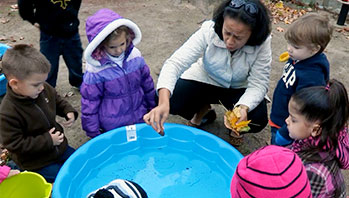- two plastic bins labeled with signs: Float and Sink
- collection of objects that float and objects that sink (rubber bands, sponges, pencils, plastic bottles with tops, rubber ball, small wrench, wooden blocks, plastic straws, craft sticks, small plastic toys)
- large clear bins with water (one for each group)
- bag
- paper and crayons
- paper towels (for spills)
- camera or cell phone with camera
- Water Rules chart
- float
- sink
MA Standards:
Language/L.PK.MA.6: Use words and phrases acquired through conversations, listening to books read aloud, activities, and play.
MA Draft STE Standards:
Physical Sciences/Matter and Its Interactions: Structure and Properties of Matter/PS1.A: Describe, compare, sort and classify objects based on observable physical characteristics, uses, and whether it is manufactured as part of their classroom play and investigations of the natural and human-made world.
Head Start Outcomes:
Logic and Reasoning/Reasoning and Problem Solving: Classifies, compares, and contrasts objects, events, and experiences.
Science Knowledge/Scientific Skills and Method: Observes and discusses common properties, differences, and comparisons among objects.
Science Knowledge/Scientific Skills and Method: Collects, describes, and records information through discussions, drawings, maps, and charts.
Science Knowledge/Conceptual Knowledge of Natural and Physical Worlds: Observes, describes, and discusses properties of materials and transformation of substances.
PreK Learning Guidelines:
English Language Arts/Language 2: Participate actively in discussions, listen to the ideas of others, and ask and answer relevant questions.
Science and Technology/Physical Sciences 19: Explore, describe, and compare the properties of liquids and solids found in children's daily environment.
Explore Together (outdoors): Explore Float and Sink

© Commonwealth of Massachusetts, Department of Early Education and Care. All rights reserved.
STEM Key Concepts: Different objects behave differently in water; Some things float; Some things sink; Solids have physical characteristics that can be observed and described
ELA Focus Skills: Compare and Contrast, Follow Directions, Listening and Speaking, Vocabulary
Educator Prep: Before the activity, create two three-column charts titled “Float and Sink.” Label the left column “Object” and show a list of the objects, each represented with an illustration or photograph and label; label the middle column “Float”; the right column “Sink.” (The “Float” and “Sink” column could also be represented with illustrations at the top of each column.) Display the charts in the area where each water bin is placed.
Begin by reviewing the basic water rules with children. Then tell children they will be exploring how different objects behave in water, whether they sink or float. Gather children around one large tub of water. Choose an object. On the chart, draw and label the object in the “Object” column of the chart.
Have children examine the object closely, as they hold it and ask them to describe some of the things they observe about the object. Encourage them to notice the material the object is made of, its size, its weight, and its shape. Then ask, Do you think it will float to the top or sink to the bottom? Have them discuss their responses.
Next, place the object in the water and have children describe what happens. Invite a volunteer to place an “X” in the “Float” or “Sink” column of the chart.
Divide children into two groups. Give each group a bin of water and an assortment of objects. Allow children the opportunity to explore the objects freely. Encourage them to predict whether they think an object will float or sink, and then record it on the chart. As children explore, be sure to observe, listen to, and engage them. Draw their attention to the characteristics and behavior of the different objects and encourage exploration by asking questions and making comments such as,
- What happened when you put the <object> in the water?
- Did that <object> sink fast or slow in the water?
- What happens if you hold the <object> down at the bottom of the water and then let go?
- I wonder what the <object> would do if you dropped it in the water from up high.
Reflect and Share
Have a few objects on display so children can reference and demonstrate as they share their observations. Review the charts. Prompt discussion with questions such as,
- Is there anything the same about any of the objects that floated?
- Look at the objects that sank. Is there anything the same about them?
- What do you think will happen if you put all of the objects in the water at the same time?
- Why do you think some objects floated when you first put them in the water, and then sank to the bottom of the water?
- Did any object float that you thought would sink? Why do you think it floated?
- Did any object sink that you thought would float? Why do you think it sank?
English Language Learners: Point to and identify each material for the activity. Have children repeat the words after you.
Adaptation: You might prefer to have very young children do the activity individually, with one-to-one supervision.
